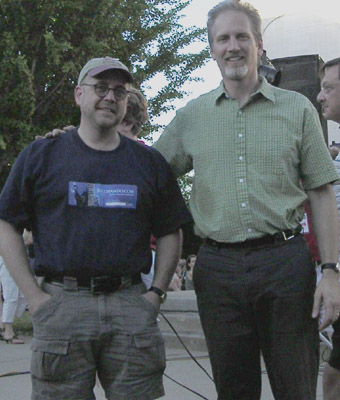« A whole new "Enterprise?" Girouard Mandolins |
Main
| Don Stiernberg talks with Mike Marshall »
 May 25, 2014 | Paul Glasse on moving from bluegrass to jazz May 25, 2014 | Paul Glasse on moving from bluegrass to jazz
We appreciate the mentoring and sound advice from Austin, Texas mandolin master, Paul Glasse. Having the privilege of several interviews and a guest appearance at a local summer jazz festival, it's been great to use these opportunities to pick his brain on playing. Having made the leap from mastering traditional bluegrass and breaking new ground applying the acoustic and 5-string electric mandolin to the a unique jazz voice, he's a go-to resource for understanding jazz mandolin.
The following is an excerpt from our interview at the Mandolin Cafe:
Question: What was the catalyst that lead you to go beyond musical genres that are more commonly associated with the mandolin (like bluegrass and Old Time) and explore swing and straight ahead jazz/bop? And, in particular, how did you initially get into post-swing forms (who were you listening to, for example)?
Paul Glasse: When I took up mandolin I originally played bluegrass and Old Time music. As I explored those interests I began to love many other kinds of rural and roots musics. My discovery of western swing and the playing of mandolinists Tiny Moore and Johnny Gimble helped nudge me toward other "non-western" swing music. I fell in love with the guitar playing of Charlie Christian and the small jazz combo settings that he often played in. Really, at that point I just followed the history of jazz. Charlie Christian led pretty logically into Charlie Parker and the world of bebop. From there Wes Montgomery and Clifford Brown were not much of a stretch to enjoy.
I think that there's really quite a bit involved in understanding a style of music such as bluegrass, swing, or bebop. It takes a lot of critical listening and, at least on my part, humbling attempts at trying to play authentically and passionately within a style. For me, it really helped to expand my own harmonic ear gradually. That is, I didn't decide I liked jazz and immediately jump into the most modern thing. I've just gradually nudged myself along and tried to settle in with the parts that speak to me. It's amusing to me that, in the mandolin world, some of what I do might be considered harmonically adventurous but in the jazz world those same ideas are based in vocabulary that's over a half century old. There's so much unexplored jazz territory on the mandolin--lots of room for innovation and unique voices.
Read article: The Paul Glasse Interview

Paul Glasse on Amazon
Artist ReverbNation page
Posted by Ted at May 25, 2014 8:14 AM

Disclaimer: In the 'Information Age' of the 21st Century,
any fool with a computer, a modem, and an idea can
become a self-professed 'expert." This site does not
come equipped with 'discernment.'
|



